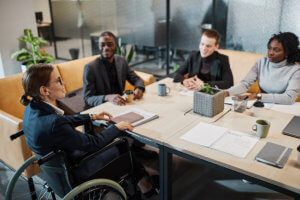 While it is well-known that Diversity, Equity, and Inclusion (“DEI”) is DEI, that discusses a philosophy & set of practices to ensure opportunity & treatment are given to employees irrespective. What is becoming more apparent is that DEI is an evolving concept that can change and include other terminology.
While it is well-known that Diversity, Equity, and Inclusion (“DEI”) is DEI, that discusses a philosophy & set of practices to ensure opportunity & treatment are given to employees irrespective. What is becoming more apparent is that DEI is an evolving concept that can change and include other terminology.
Our DEI strategist, Jon Orozco, MBA, SHRM-SCP., describes the evolution of DEI and the new terminology, acronym, and actionable items your organization can take. He suggested that for DEI to be genuinely inclusive, it needs to incorporate “accessibility” so it can resolve more problems in the workplace that affect every person.
Accessibility Training – Insights & Actions
Insight: Accessibility means the design, construction, development, and maintenance of facilities, information and communication technology, programs, and services. All people, including people with disabilities, can fully and independently use them. People with disabilities are as diverse as those without such impairments. Therefore, designers and builders must include all people in designing and building facilities to ensure accessibility for people of all abilities. This will enable access to opportunities and employment. When planning, creating, developing, or maintaining new jobs and job descriptions with the essential functions, consideration is to be given to all people. By being mindful of job descriptions and approaching them from a holistic approach, people with disabilities will have access to more opportunities.
Action: Accessibility can also mean usability and access, the way they encounter it, with various definitions for different groups of people. For example, accessibility can mean being flexible and open-minded towards hiring individuals with invisible disabilities to an organization; neurodiversity and mental health are two examples.
 Insight: While it is true that the United States struggled with providing access to all citizens’ varying capabilities, it did make a push by rolling out access rights that were granted with the American Disabilities Act of 1990 (“ADA”). The ADA bill contained rights prohibiting discrimination against people with disabilities in everyday activities, like employment, public transportation, and accessing public buildings. Accessibility means the ability for all people to participate and be included in society and their communities. Ultimately, accessibility ensures that everyone can use all physical spaces, information, technology, programs, and services. That might mean that the company looks outward for experts that provide specialized furniture to enable people with disabilities to properly enjoy all the infrastructure in the space.
Insight: While it is true that the United States struggled with providing access to all citizens’ varying capabilities, it did make a push by rolling out access rights that were granted with the American Disabilities Act of 1990 (“ADA”). The ADA bill contained rights prohibiting discrimination against people with disabilities in everyday activities, like employment, public transportation, and accessing public buildings. Accessibility means the ability for all people to participate and be included in society and their communities. Ultimately, accessibility ensures that everyone can use all physical spaces, information, technology, programs, and services. That might mean that the company looks outward for experts that provide specialized furniture to enable people with disabilities to properly enjoy all the infrastructure in the space.
Action: Have an HR professional on your team specialize in ADA reasonable accommodations and find ways for the organization to be more inclusive and welcoming. For example, ADA suggests that employers provide qualified readers for those who are visually impaired and interpreters for those who are deaf or hard of hearing.
Insight: Most employees, and even HR professionals, still lack the foundational knowledge (the essentials) of DEI concepts. It is essential to use unambiguous words to explain diversity, equity, and inclusion, especially in this current climate, as it communicates respect, reduces biases & stereotypes, and helps minimize microaggressions.
Action: Employers should assess the knowledge gaps within their organization that might be creating unnecessary problems. Consider taking an e-Learning of DEI to learn the essentials. When your organization is ready to begin its DEI journey, schedule a time with a DEI strategist to map out your plan to roll out DEI training to your organization.
There are also groups of people who may not be considered “able-bodied” and so may not have access to experiencing certain types of activities or events. The aim is to provide a reasonable accommodation for them by making your resources accessible to everyone. Good accessibility training for HR professionals and management staff can dramatically improve outcomes.
Imagine buildings, information systems, communication technology, and the programs that people use every day that are safe for everyone. Now imagine that anybody can independently use it – that is accessibility! In simple terms, accessibility means meeting the needs of every person in the company culture. The best accessibility training gets everyone involved.
For general information, visit our website today; www.compliancetraininggroup.com







